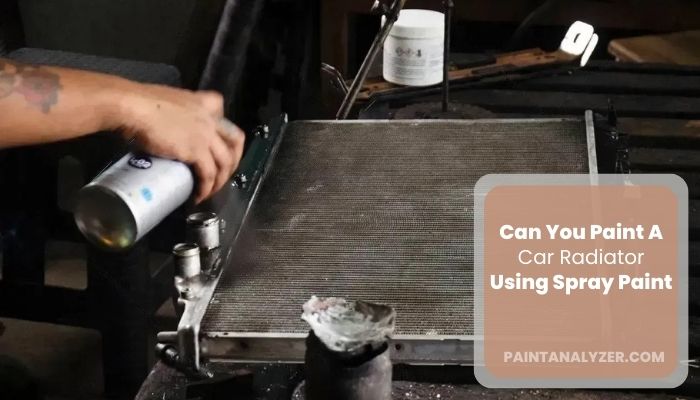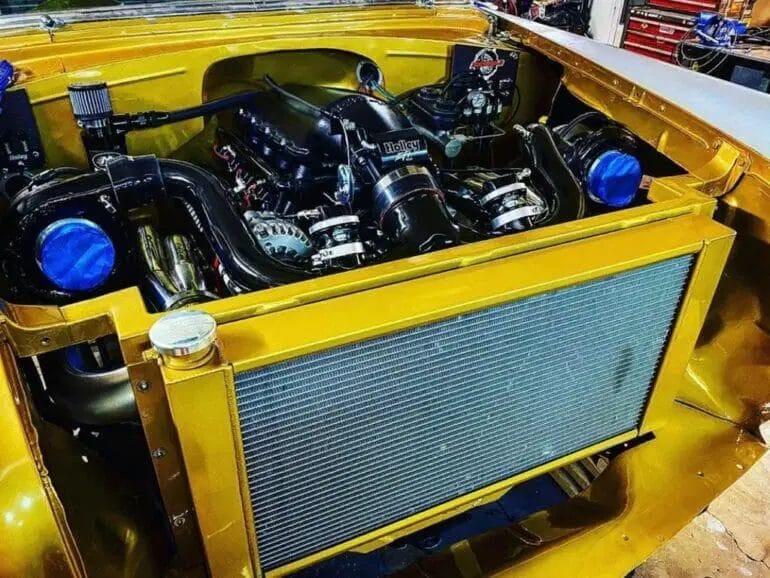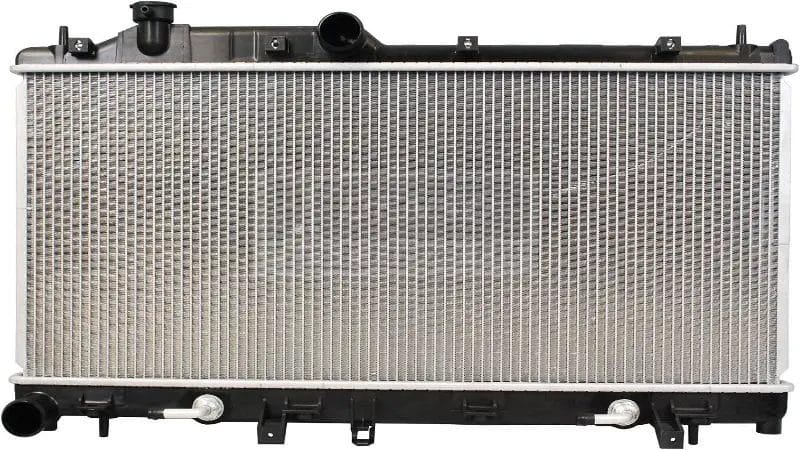If you’re looking to give your car radiator a fresh and vibrant new look, painting it can be a great option. By using specially formulated heat-resistant paint, you can not only enhance the appearance of your radiator but also protect it from rust and corrosion. With a few simple steps and the right tools, painting your car radiator can be a DIY project that adds a unique touch to your vehicle’s engine bay. In this guide, we’ll walk you through the process of painting a car radiator, from preparation to finishing touches.

DIY Guide: How to Paint a Car Radiator
Painting a car radiator can not only enhance the overall appearance of your vehicle’s engine bay, but it can also provide added protection against rust and corrosion. In this guide, we will walk you through the step-by-step process of painting a car radiator, allowing you to achieve professional results right at home.
Gather the Necessary Materials
Before you begin, it’s important to gather all the necessary materials for this project. Here’s what you’ll need:
- Car radiator paint
- Sandpaper (grit: 220 and 400)
- Wire brush
- Masking tape
- Newspaper or drop cloth
- Clean cloth
- Spray bottle with water
- Painters’ gloves
- Respirator mask
Preparation
The key to a successful paint job is proper preparation. Follow these steps to prepare the radiator:
- Ensure the engine is completely cool before starting.
- Disconnect the negative terminal of the car battery.
- Cover the surrounding areas with newspaper or a drop cloth to protect them from overspray.
- Remove any loose dirt or debris from the radiator’s surface using a clean cloth.
- Use a wire brush to remove any flaking paint or rust from the radiator. Be gentle to avoid damaging the fins.
- Lightly sand the entire surface of the radiator with 220-grit sandpaper. This will create a rough texture for better paint adhesion.
- Wipe down the radiator with a clean cloth to remove any dust or residue.
- Mask off any areas you don’t want to paint using masking tape.
Painting the Radiator
Now that the radiator is properly prepared, it’s time to start painting. Follow these steps:
- Put on your painters’ gloves and respirator mask to protect yourself from fumes.
- Shake the can of car radiator paint vigorously for a few minutes to ensure proper mixing.
- Hold the can approximately 8-12 inches away from the radiator’s surface.
- Start spraying the paint in smooth, even strokes, moving from left to right or top to bottom. Avoid overspraying in one area.
- Allow the first coat to dry completely. Refer to the instructions on the paint can for drying times.
- If necessary, apply a second coat to achieve the desired coverage. Remember to allow each coat to dry fully.
Finishing touches
Once the final coat is dry, it’s time to remove the masking tape and inspect the painted radiator. Use a clean cloth to wipe away any overspray or smudges.
Summary
Painting a car radiator is a DIY project that can greatly improve the overall look of your vehicle. By following this step-by-step guide and using the right materials, you can achieve professional results and protect your radiator from rust and corrosion. Remember to always prioritize safety by wearing the appropriate protective gear and working in a well-ventilated area. Now, it’s time to transform your car’s engine bay with a fresh coat of paint on the radiator!
Choosing the Right Paint for Your Car Radiator
When it comes to maintaining the performance and aesthetics of your car, the radiator is an essential component to consider. The radiator not only helps in cooling down the engine but also adds to the overall visual appeal of the vehicle. To ensure that your radiator remains in top condition, it is important to choose the right paint for it. In this section, we will discuss the factors to consider while selecting the paint for your car radiator.
1. Heat Resistance
One of the most important aspects to consider when choosing paint for your car radiator is heat resistance. The radiator operates at high temperatures, so the paint needs to withstand the heat without blistering, discoloration, or peeling. Look for paints that are specifically designed to handle high temperatures, such as automotive engine enamels or heat-resistant paints. These types of paints are formulated to withstand the extreme heat generated by the radiator.
2. Compatibility
It is crucial to choose a paint that is compatible with the materials used in the construction of your car radiator. Most radiators are made of aluminum, brass, or a combination of both. Different types of paints adhere differently to these materials. Make sure to check the paint manufacturer’s specifications to ensure that the paint is suitable for the radiator’s construction material. Using the wrong type of paint can lead to poor adhesion and premature paint failure.
3. Durability
A car radiator is exposed to various elements, including moisture, dirt, and road debris. Therefore, it is essential to choose a paint that offers excellent durability and protection. Look for paints that are resistant to corrosion, rust, and UV damage. These paints will not only enhance the appearance of the radiator but also provide long-lasting protection against environmental factors.
4. Application Method
The method of applying the paint is another factor to consider. Some paints require specific application techniques, such as spraying, while others can be applied with a brush or roller. Consider your painting skills and equipment available before deciding on the paint type. Additionally, opt for paints that offer easy application and good coverage to ensure a smooth and even finish on the radiator.
5. Color Options
While the primary function of the radiator is to cool the engine, there’s no harm in choosing a paint color that complements the overall look of your car. Many automotive paint manufacturers offer a wide range of color options, allowing you to personalize your radiator. Whether you prefer a classic black or a vibrant custom color, make sure to choose a paint that is specifically formulated for automotive use.
In summary, choosing the right paint for your car radiator is crucial for maintaining its performance and enhancing the visual appeal of your vehicle. Consider factors such as heat resistance, compatibility with radiator materials, durability, application method, and color options when selecting the paint. By choosing a high-quality paint that meets these criteria, you can ensure that your car radiator remains in top condition for years to come.
Preparation Tips for Painting a Car Radiator
Painting a car radiator is not only a great way to enhance the look of your vehicle, but it also helps protect the radiator from rust and corrosion. However, before you jump into the painting process, it’s important to properly prepare the radiator to ensure a smooth and long-lasting finish. In this section, we will discuss some essential preparation tips for painting a car radiator.
Gather the Necessary Supplies
Before you start prepping your car radiator for painting, it’s important to gather all the necessary supplies. You will need:
- Protective gloves and goggles
- Sandpaper or sanding block
- Primer
- High-temperature paint
- Clean lint-free cloth
- Tape or plastic sheeting for masking
- Cleaner or degreaser
Disconnect the Radiator
The first step in preparing the radiator for painting is to disconnect it from the vehicle. This may involve removing the hoses, clamps, and any other components that are attached to the radiator. Make sure to carefully follow the manufacturer’s instructions or consult a professional if you’re not familiar with the process.
Clean the Radiator
Once the radiator is disconnected, it’s important to clean it thoroughly to remove any dirt, grime, or grease. You can use a cleaner or degreaser specifically designed for automotive parts. Apply the cleaner to a clean lint-free cloth and gently wipe down the entire surface of the radiator. Make sure to clean both the inside and outside of the radiator to ensure optimal results.
Sand the Surface
After cleaning the radiator, you’ll need to sand the surface to create a smooth and even base for the paint to adhere to. Use sandpaper or a sanding block to gently sand the entire surface of the radiator. This will help remove any rough spots, old paint, or imperfections. Be careful not to apply too much pressure, as it may damage the radiator.
Masking
Before you start applying primer and paint, it’s crucial to mask off any areas that you don’t want to be painted. Use tape or plastic sheeting to cover the surrounding components and protect them from overspray. This will help ensure a clean and professional-looking finish.
Apply Primer
Priming is an important step in the painting process as it helps the paint adhere better and provides an even base coat. Apply a high-quality primer specifically designed for use on automotive radiators. Follow the manufacturer’s instructions for application and drying times. Make sure to apply the primer evenly and avoid heavy coats that may lead to drips or runs.
Paint the Radiator
Once the primer is dry, it’s time to paint the radiator. Choose a high-temperature paint that is compatible with your radiator and provides a durable finish. Apply the paint in thin, even coats, allowing sufficient drying time between each coat. This will help achieve a smooth and professional-looking finish. Remember to follow the manufacturer’s instructions for application and drying times.
Reconnect the Radiator
After the paint is completely dry, you can reattach the radiator to your vehicle. Make sure to carefully reconnect all the hoses, clamps, and other components, ensuring a proper seal. Double-check everything to ensure that there are no leaks or loose connections.
Final Tips
Here are a few additional tips to keep in mind when painting a car radiator:
- Work in a well-ventilated area to avoid inhaling fumes.
- Follow all safety precautions mentioned on the paint and primer labels.
- Avoid painting on a rainy or humid day, as it may affect the drying process.
- Allow the radiator to dry completely before starting the vehicle.
- Regularly check the radiator for any signs of damage or corrosion and address them promptly.
By following these preparation tips, you can ensure a successful and long-lasting paint job for your car radiator. Always remember to take your time, work diligently, and prioritize safety throughout the process. Happy painting!
Step-by-Step Process of Painting a Car Radiator
Painting a car radiator not only enhances the aesthetics of your vehicle but also protects the radiator from corrosion and damage. It is a simple DIY project that you can easily complete with the right tools and materials. In this section, we will guide you through the step-by-step process of painting a car radiator.
Materials You Will Need:
- Car radiator
- Sandpaper (120-grit and 240-grit)
- Masking tape
- Primer spray paint
- Paint spray paint
- Clear coat spray paint
- Newspaper or drop cloth
- Gloves
- Respirator mask
Step 1: Preparation
Start by disconnecting the car battery to ensure safety. Place the car in a well-ventilated area or outdoors to avoid fumes inhalation. Protect the surrounding areas of the radiator by covering them with newspaper or a drop cloth.
Step 2: Cleaning
Use a soft cloth or brush to remove any loose dirt or debris from the radiator surface. Then, mix a mild detergent with water and clean the radiator thoroughly. Rinse off the detergent with clean water and allow the radiator to dry completely.
Step 3: Sanding
Take the 120-grit sandpaper and gently sand the surface of the radiator. This will help the paint adhere better to the metal. Follow up with the 240-grit sandpaper to smooth out any rough areas. Wipe away any dust or debris with a clean cloth.
Step 4: Masking
Use masking tape to cover any parts of the radiator that you don’t want to paint, such as the filler neck or any sensors. Make sure the tape is applied securely to avoid any paint seeping through.
Step 5: Priming
Shake the primer spray paint can thoroughly. Hold the can about 8-12 inches away from the radiator and apply a light, even coat of primer. Allow it to dry according to the manufacturer’s instructions. Apply a second coat if necessary for better coverage.
Step 6: Painting
Once the primer is dry, shake the paint spray can well. Apply multiple thin coats of paint, allowing each coat to dry before applying the next. This will help achieve a smooth and even finish. Be patient and avoid rushing the process.
Step 7: Clear Coat
After the paint has dried, apply a clear coat spray paint to protect the paint and add a shine to the radiator. Follow the manufacturer’s instructions for the drying time between coats. Apply 2-3 coats for optimal results.
Step 8: Final Touches
Once the clear coat is dry, carefully remove the masking tape. Inspect the painted radiator for any imperfections or areas that need touch-ups. Use a fine brush and matching paint to fix any blemishes.
Step 9: Reinstallation
Allow the paint to fully cure before reinstalling the radiator. Reconnect any hoses or connectors that were disconnected during the painting process. Finally, reconnect the car battery.
Summary
Painting a car radiator can be a rewarding DIY project that adds a personal touch to your vehicle. By following these step-by-step instructions, you can achieve a professional-looking finish while protecting your radiator from damage. Remember to take proper safety precautions and ensure good ventilation when working with paint and spray cans. Enjoy the process and admire your newly painted car radiator!
Maintenance and Care for a Painted Car Radiator
Car radiators play a crucial role in keeping your engine cool and preventing overheating. While most radiators come in a standard silver or black finish, some car enthusiasts choose to add a personal touch by painting their radiators. A painted car radiator can enhance the overall look of your vehicle and give it a unique appearance. However, it is essential to properly maintain and care for a painted car radiator to ensure its longevity and optimal performance.
1. Regular Cleaning
One of the most important steps in maintaining a painted car radiator is regular cleaning. Over time, dirt, dust, and debris can accumulate on the surface of the radiator, affecting its cooling efficiency. To clean a painted radiator, start by cooling down the engine completely. Then, using a soft brush or cloth, gently remove any loose dirt or debris from the radiator fins and the painted surface. Avoid using abrasive materials or harsh chemicals that can damage the paint. Finally, rinse off any remaining dirt or debris with low-pressure water.
2. Inspection for Damage
It is crucial to regularly inspect your painted car radiator for any signs of damage. Look for chipped or peeling paint, as well as any dents or bent fins. If you notice any damage, it is essential to address it promptly to prevent further deterioration. Small chips or scratches can be touched up with matching paint, while larger areas of damage may require repainting. Additionally, check for any leaks or rust on the radiator, as these can indicate more significant issues that need immediate attention.
3. Avoiding Chemical Exposure
When caring for a painted car radiator, it is important to avoid exposure to chemicals that can damage the paint. This includes certain cleaning products, gasoline, brake fluid, and coolant. If any of these substances come into contact with the painted surface, quickly rinse it off with water to minimize potential damage. Additionally, avoid using abrasive materials or rough brushes that can strip off the paint. By taking precautions, you can preserve the integrity of the painted radiator surface.
4. Protection from the Elements
Another vital aspect of maintaining a painted car radiator is protecting it from harsh weather conditions and other environmental factors. Extreme temperatures, sunlight, rain, and snow can all impact the durability and appearance of the paint. Consider parking your vehicle in a covered area or using a car cover when it is not in use to shield the radiator from direct exposure. Additionally, applying a layer of wax or sealant to the painted surface can provide an extra barrier against the elements.
5. Professional Touch-ups
If you have a painted car radiator and notice significant damage or wear over time, it is best to seek professional help for touch-ups or repainting. Automotive paint specialists have the necessary expertise and equipment to match the original paint color and apply it seamlessly. Trying to fix extensive damage yourself may lead to inconsistent results or further damage to the radiator. Investing in professional touch-ups will ensure that your painted radiator continues to look its best.
Summary
In summary, maintaining and caring for a painted car radiator requires regular cleaning, inspection for damage, avoiding chemical exposure, protecting it from the elements, and seeking professional help for touch-ups when needed. By following these guidelines, you can ensure that your painted radiator remains in top condition, adding a personalized touch to your vehicle while also functioning efficiently.

FAQs
Can you paint a car radiator?
No, it is not recommended to paint a car radiator. The paint can interfere with the radiator’s ability to dissipate heat, leading to potential overheating issues. It is best to leave the radiator unpainted for optimal performance.

Conclusion:
In conclusion, painting a car radiator is not recommended. While it may seem like a simple solution to enhance the appearance of your vehicle, painting the radiator can have serious consequences. The paint can inhibit heat dissipation, causing the engine to overheat and potentially lead to engine damage. Additionally, the paint may not adhere properly to the radiator’s surface, resulting in peeling and flaking over time. It is crucial to prioritize the functionality and performance of your car’s cooling system, rather than focusing solely on aesthetics. Therefore, it is best to leave the radiator unpainted and ensure regular maintenance to keep your vehicle in optimal condition.
